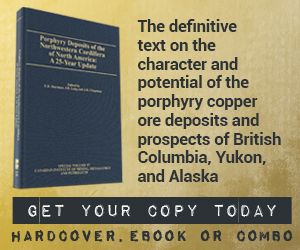Library Magazine Articles International resource and reserve reporting
International resource and reserve reporting
Deborah McCombe - Mar 2008
By now, most geologists and engineers in the Canadian mining industry are familiar with National Instrument 43-101 Standards of Disclosure for Mineral Projects (NI 43-101) and the Canadian Institute of Mining, Metallurgy and Petroleum (CIM) Definition Standards for Mineral Resources and Mineral Reserves, which are incorporated by reference in NI 43-101.
In recent years, significant progress has also been made in establishing standard reporting practices internationally that recognize the globalization of the industry and enable investors to compare projects anywhere in the world and make informed investment decisions.
This article is part of a series that will summarize the background and development of international resource and reserve reporting standards by the Committee for Mineral Reserves International Reporting Standards (CRIRSCO), highlight its current activities and provide insight into international mineral reserve and resource reporting issues.
CRIRSCO was formerly the Mineral Definitions Working Group of the Council of Mining and Metallurgical Institutions (CMMI), an organization representing professional bodies in all of the major mining and mining investment countries. In 2002, CMMI disbanded and CRIRSCO continued as a volunteer committee with limited funding from those professional bodies and increasingly from other sources, such as mining companies and regulatory bodies.
CRIRSCO was adopted as a Task Force of the International Council of Mining and Metals (ICMM) in 2007. The ICMM is an influential industry body representing all of the major mining companies and many junior companies through its associated members, such as the Minerals Council of Australia, the Chamber of Mines of South Africa and the Prospectors and Developers Association of Canada.
CRIRSCO now has funding to pursue its objectives.
National Reporting Organizations (NROs), such as CIM in Canada, now provide the members of CRIRSCO, normally two per NRO, who work in a voluntary capacity on a wide range of issues affecting international mineral resource and reserve reporting. Niall Weatherstone, a representative of the Pan- European Reserves Reporting Committee (PERC), is the chairman. The current members of the committee include:
- Ferdi Camisani and Roger Dixon, South Africa Mineral Resource Committee (SAMREC), South Africa
- Peters Stoker and Ian Goddard, Joint Ore Reserves Committee (JORC), Australia
- John Clifford, PERC, Ireland and Western Europe
- Edmundo Tulcanaza, Institute of Mining Engineers of Chile (IMEC), Chile
- Jean-Michel Rendu and Harry Parker, Society for Mining, Metallurgy and Exploration (SME) in the United States
- Deborah McCombe and John Postle, CIM, Canada
The aim of CRIRSCO is to promote high standards in the international public reporting of exploration results and estimates of mineral resources and mineral reserves. It aims to achieve its stated objectives by:
- Promoting uniformity, excellence and continuous improvement in national and international reporting standards for mineral exploration results and mineral resources and reserves.
- Representing the international minerals industry on mineral resources and mineral reserve reporting issues, including discussions with international organizations.
- Encouraging the continued development of international reciprocity of qualified/competent persons through nationally based recognized overseas professional organizations or equivalents.
- Promoting the use of uniform and clear best practice reporting standards for mineral exploration results and mineral resources and reserves, including the provision and maintenance of the CRIRSCO International Reporting Template.
- Facilitating the exchange of information and dialogue among CRIRSCO members and other stakeholders through an actively managed website that promotes discussion on current issues (www.crirsco.com).
Considerable strides have taken place in international reporting standards in the last eight years. Prior to 1999, only the Australian JORC Code was recognized as an “international standard in mineral resource and ore reserve reporting.”
As noted by Niall Weatherstone, since 1999, many new national reporting standards have been released: the United States (1999, 2005 draft), South Africa (2000 and 2007), UK/Ireland and Western Europe (2001, 2007 in preparation), Peru (2003), Canada (2000 and 2005), Australasia (JORC updated 2004) and Chile 2004. On December 31, 2007, the Chilean Code for Reporting Mineral Prospects, Resources, and Reserves was approved and published as a law in Chile. All of these standards are similar as CRIRSCO members from the various countries participated in their development.
It is essential that each national reporting standard has to respond to the regulatory requirements of its host country if it is to have any legal force. Thus, in Canada for example, the CIM reporting standards are incorporated by reference in the Canadian Securities Administrators’ NI 43-101. Similar linkages occur in Australia, South Africa (JSE Listing Rules), Chile and Peru.
In July 2006, CRIRSCO released the International Reporting Template, intended as a form of generic “code.” The template serves as a guide to national reporting bodies that do not have a reporting standard or who want to revise their historical standard to an internationally acceptable form. The goal is to have clear, uniform rules and guidelines so the public can make informed investment decisions on projects anywhere in the world.
For additional information on the background of CRIRSCO, see P.R. Stephenson and N. Weatherstone, Developments in International Mineral Resource and Reserve Reporting (www.shop.ausimm.com.au).
About the Author
Deborah McCombe is executive vice president, Scott Wilson Mining Group.

.png)
